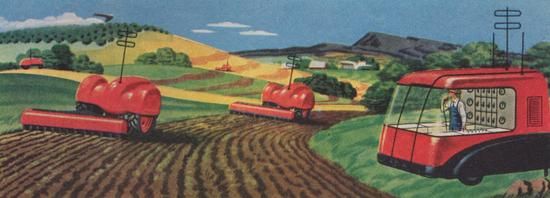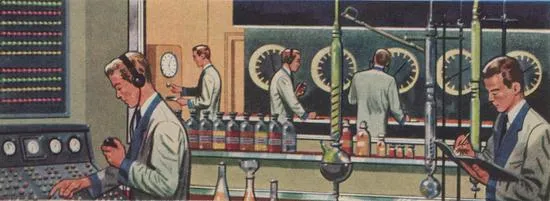Aldous Huxley’s Predictions for 2000 A.D.
The famous author envisioned a brave new world where swelling populations would put tremendous strain on the Earth’s resources
/https://tf-cmsv2-smithsonianmag-media.s3.amazonaws.com/filer/20121101094120you-in-2000-470x251.jpg)
![]() There seems to be two occasions when people most enjoy making predictions: anniversaries (think the American Bicentennial, New Year’s, etc) and dates that include round numbers (any year ending in zero). Such was the case in 1950 when many people halfway through the 20th century enjoyed predicting what life would be like in the year 2000 — obviously the roundest numbered year of our modern age.
There seems to be two occasions when people most enjoy making predictions: anniversaries (think the American Bicentennial, New Year’s, etc) and dates that include round numbers (any year ending in zero). Such was the case in 1950 when many people halfway through the 20th century enjoyed predicting what life would be like in the year 2000 — obviously the roundest numbered year of our modern age.
The January 1950 issue of Redbook magazine asked, “What will the world of 2000 A.D. be like? Will the machine replace man? How will our children and grandchildren spend their leisure? How, indeed, will they look?” The mag asked four experts — curiously all men, given that Redbook was and is a magazine aimed at women — about what the world may look like fifty years hence.
Aldous Huxley, author of the 1931 dystopian novel Brave New World, looked at working life in the year 2000. Specifically, how people might work in the home, in the laboratory, in the office, in the factory and on the farm.

Aldous Huxley began his article by describing the major challenges that would confront the world at the dawn of the 21st century. He predicted that the global population would swell to 3 billion people — a figure less than half of the 6.1 billion that would prove to be a reality by 2000.
During the next fifty years mankind will face three great problems: the problem of avoiding war; the problem of feeding and clothing a population of two and a quarter billions which, by 2000 A.D., will have grown to upward of three billions, and the problem of supplying these billions without ruining the planet’s irreplaceable resources.
Let us assume—and unhappily it is a large assumption—that the nations can agree to live in peace. In this event mankind will be free to devote all its energy and skill to the solution of its other major problems.
Huxley’s predictions for food production in the year 2000 are largely a call for the conservation of resources. He correctly points out that meat production can be far less efficient than using agricultural lands for crops. Moreover, he discusses the growing importance of synthetic materials (a reality we take for granted in so many ways today). His description of synthetics was incredibly prescient, if not very surprising, coming from a man whose most famous novel imagined a high-tech world built on mass production.
By 2000, let us hope, the peoples of the world will have adopted a program to increase the planet’s output of food and other necessities, while conserving its resources. Because all available land will be needed for food production, concerted efforts will be made to derive all the fibers used for textiles from inorganic materials or vegetable wastes. Food crops will be cultivated on the land now devoted to cotton, flax, hemp and jute, and, since wool will no longer be used, the huge flocks of sheep which now menace Australian and North American watersheds will be greatly diminished. Because of the need to give overworked soil a rest and to extract the greatest possible number of calories from every acre under cultivation, meat production, which is fantastically wasteful of land, will be cut down, and increasing attention will be given to the products, vegetable no less than animal, of the ocean. Landlocked inlets, lakes, ponds and swamps will be scientifically farmed.
In many parts of the world forests are being recklessly destroyed. To conserve them we shall have to develop new types of synthetic building materials and new sources for paper. That the production of a comic supplement should entail the death of thousands of magnificent trees is a scandal which cannot much longer be tolerated.
How will individuals be affected by all this? For many farmers the changes will mean a shift from one kind of production to another. For many others they will entail a transfer to the chemical industry. For the chemical industry is bound to grow more important as world erosion compels us, for the sake of the land, to rely increasingly on synthetics derived from practically inexhaustible inorganic materials.

The world of 2000 A.D. was seen by many to be one of increased leisure. But Huxley sees that potential for better working conditions and increased standards of living as obtainable only through a sustained peace. These same predictions of a leisure-oriented society, by Huxley and others living mid-century, would inspire the push-button cliche later parodied in the 1962 TV show “The Jetsons.”
Perhaps Huxley’s most inaccurate prediction is his assumption that an increase in productivity will mean an increase in wages for the average worker. As we’ve seen over the last half a century, increased worker productivity has not led to a dramatic increase in wages.
That enormous technological advances will be recorded during the next fifty years is certain. But to the worker as a worker, such advances will not necessarily be of great significance. It makes very little difference to the textile worker whether the stuff he handles is the product of a worm, a plant, a mammal or a chemical laboratory. Work is work, and what matters to the worker is neither the product nor the technical process, but the pay, the hours, the attitude of the boss, the physical environment. To most office and factory workers in 2000 the application of nuclear fission to industry will mean very little. What they will care about is what their fathers and mothers care about today—improvement in the conditions of labor. Given peace, it should be possible, within the next fifty years, to improve working conditions very considerably. Better equipped, workers will produce more and therefore earn more. Meanwhile most of the hideous relics of the industrial Middle Ages will have been replaced by new factories, offices and homes. More and more factories and offices will be relocated in small country communities, where life is cheaper, pleasanter and more genuinely human than in those breeding-grounds of mass neurosis, the great metropolitan centers of today. Decentralization may help to check that march toward the asylum, which is a threat to our civilization hardly less grave than that of erosion and A-bomb.
Huxley rightly predicts that the world would have to face the challenges that go along with having an aging population. Huxley himself would only live to see the year 1963, but he acknowledged what life would be like for young people reading his article.
If the finished product means little to the worker, it means much to the housewife. New synthetic building materials will be easier to keep clean. New solar heating systems will be cheaper and less messy. Electronics in the kitchen will greatly simplify the task of the cook. In a word, by 2000 the business of living should have become decidedly less arduous than it is at present. But, though less arduous, it will last on the average a good deal longer. In 2000 there will be more elderly people in the world than at any previous time. In many countries the citizens of sixty-five and over will outnumber the boys and girls of fifteen and under. Pensions and a pointless leisure offer no solution to the problems of an aging population. In 2000 the younger readers of this article, who will then be in their seventies, will probably be inhabiting a world in which the old are provided with opportunities for using their experience and remaining strength in ways satisfactory to themselves, and valuable to the community.

All in all, I’d say that Huxley’s predictions were fairly accurate in spirit. Like so many prominent people of mid-century, he fails to predict or consider the dramatic social changes that would occur which had a direct impact on the 21st century workforce. But his idea that “work is work” and people simply want to find the best work they can with the best conditions and pay seems to be a timeless observation.
What do you say? I’m by no means an expert on Huxley and would welcome the opinion of others who may be able to read between the lines and offer insight into his vision of the year 2000.
/https://tf-cmsv2-smithsonianmag-media.s3.amazonaws.com/accounts/headshot/matt-novak-240.jpg)
/https://tf-cmsv2-smithsonianmag-media.s3.amazonaws.com/accounts/headshot/matt-novak-240.jpg)